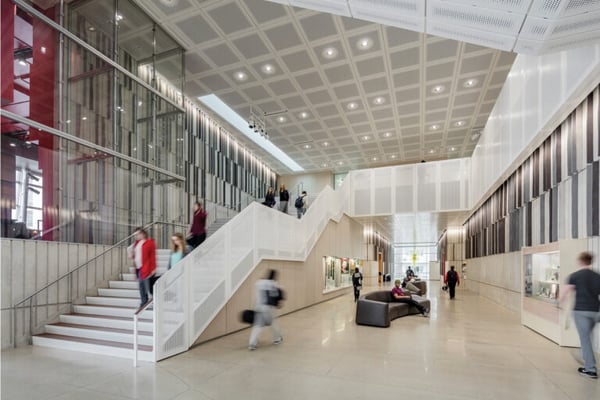Benchmarking Tours: What to Expect and Who to Include

At the start of a building project, your goals may be unclear, and you may not know where to begin. Fortunately, the architectural process presents many opportunities to gather and explore ideas.
Benchmarking is one such opportunity. At Neumann Monson, we use benchmarking tours to help our clients think outside the box and determine what they need from their new space. Benchmarking sets the foundation for the design process and helps you and your architect discover more effective solutions.
This article will break down the benchmarking process by answering the following questions:
- What is benchmarking?
- What can you expect from a benchmarking tour?
- What are the benefits of participating?
- Who should you include?
- What kind of commitment is involved?
After reading, you will understand the importance of benchmarking and how you and your team can prepare.
What is Benchmarking?
Benchmarking is the process of researching facilities similar to the one you are planning. Your architect will search for buildings that mirror your project in terms of building type, size, and programming elements. To further narrow the search, they may also look for projects with a similar budget.
Your architect will then recommend places to tour. This process can be done for any building or client type. We’ve led tours of churches, recreation centers, academic institutions, multi-family housing, and commercial spaces.
What Can You Expect from a Benchmarking Tour?
Benchmarking tours present an opportunity to think outside the box and imagine new ways of working and living. If you don’t explore other facilities, you may limit your perspective to your current environment. Seeing different facilities allows you to consider different ways of approaching the problems with your current space.
Your architect may begin with a tour of your current facility. You and your team will walk through the space and express your thoughts and opinions:
- What’s working?
- What isn’t working?
- What would you like to be different in your new space?
This process establishes a baseline before touring other facilities and gets everyone on the same page. When you tour other facilities, you’ll be encouraged to express your opinions once again:
- How does this space “feel” different from your current space?
- Does a particular material or finish catch your eye?
- Does this space align with your vision?
With this information, your architect can better understand your needs and plan the design accordingly.
At the same time, you will get to talk with the facility’s occupants. This is a chance to learn from their past experiences and how their decisions have impacted their daily operations. You might ask them:
- What works with your current facility?
- What do you wish you would have done differently?
- What do you wish you would have known/considered before starting the design and construction process?
These conversations will provide a fresh perspective and open your team to new approaches to your project.

A benchmarking tour can help you imagine new ways of approaching your building project.
What are the Benefits of Participating in a Benchmarking Tour?
Benchmarking tours can introduce you to the latest practices in architecture and interior design, helping you keep up with others in your market. Regardless of your industry, your building plays a key role in talent attraction, retention, and workplace productivity. Benchmarking tours help you stay ahead of the curve.
This is especially true for developers. Benchmarking introduces you to the latest technologies and design trends, helping you make your building even more attractive to tenants.
At the same time, tours establish a common language for your building project. As you explore schematic design concepts, you can articulate your opinions by referencing facilities you’ve seen together.
From an architect’s perspective, benchmarking makes the design process more efficient and intentional. Your architect can quickly get a feel for your needs and produce concepts that align with your vision. Investing the time to explore other facilities will help you in the long run.
Who Should You Include?
You can include any number of people in a benchmarking tour. Generally, we recommend including anyone with a financial stake in the project and anyone who will participate in design conversations.
We also recommend including people who are not directly involved in the design process but will use the space. For example, we’ve recommended a commercial manufacturing company include individuals who work on the factory floor.
It’s important to include the perspective of those who use the space daily. The more perspectives you can include in the early stages of design, the more impactful the project.

We recommend including those who will use the space daily.
What Commitment is Involved?
Before starting the benchmarking process, prepare for a time commitment outside your daily job. The typical tour will take half a day, and after the tour, you will discuss your thoughts with your architect. You will also need to account for travel time and lodging expenses, depending on where you visit.
Can This Be Done Virtually?
In 2020, some clients opted for virtual benchmarking tours. Via Zoom, we presented pictures and floorplans and asked clients for feedback. Although necessary due to the pandemic, these virtual tours were far less effective than a traditional, in-person tour.
Pictures are highly controlled and do not fully capture the experience of a building. It’s important to walk through the building, get a feel for the space, and talk with occupants. The time and expenses of travel are worthwhile. A building project is a large investment, and benchmarking will help you make well-informed decisions.
What Are Your Next Steps?
Benchmarking is an essential part of the architectural process. By touring similar facilities and talking to your peers, you can reset your expectations and open your mind to new possibilities. As you continue through the design process, the insights you gain from the benchmarking process will provide a shared language through which you and your team will discuss your ideas.
Now that you better understand benchmarking, learn how an architect can further engage your team by reading our guides to programming and visioning workshops.
To learn how we can help with your project, contact us, and schedule a phone call with a project manager.